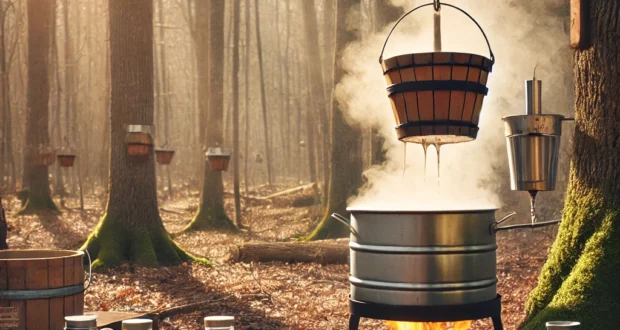Blog
A short guide to tradition and production
Heritage of maple syrup
Well, this season again. Go outside and find a few sugar clones. Let’s start. This is cool! What’s more, this is a great tradition of passing on to children and grandchildren. Here is the review:
Maple syrup, sweet and valued natural product of North America, has a history preceding the European settlement. The native peoples of the Great Lakes and the regions of the St. Lawrence was the first to discover its value, using it as a commercial goods and the basis in their diet.
The process of knocking maple trees and reducing juice into syrup remained extremely coherent for centuries, evolving with modern techniques, while maintaining a relationship with nature and tradition.
Understanding the gift of a maple tree
The production of maple syrup begins with the trees themselves. Sugar maple (Acer Sacharyum), also known as rocks or hard clone, is the best SAP producer due to the high sugar content, on average about two to three percent. Red clones (Acer Rubrum) can also be tapped, although their juice is often less sweet.
This process is based on the natural cycle of freezing and thawing early spring, which cause pressure inside the tree, causing the flow of juice after inserting the tap. The transformation of the stored starch in sugar in a tree gives the maple juice its clear sweetness.
The art of knocking maple trees
To ensure balanced harvest, trees must reach at least 10 inches in diameter before you can knock them. Larger trees can accommodate more taps, but no tree should have more than three.
Touching involves drilling a small hole to a tree at a slight angle up, inserting a spout and suspension of a bucket with a collection or connecting a tube for transporting juice. Time is crucial – the taps should be placed when the temperatures during the day rises above the freezing, but the nights remain cold, ensuring constant flow of juice.
SAP collection and storage
After collecting, the SAP must be treated carefully, because it is very easily spoiling. Like fresh milk, it can break quickly if left in warm conditions. To maintain its quality, SAP should be preserved and processed as soon as possible.
The amount of SAP that the tree produces is different. Despite this, the production of a single quarter of maple syrup takes about 10 gallons. Some trees can bring to 80 gallons in the season in ideal conditions.
SAP transformation in syrup is both science and art.
Boiling process: transformation of juice into syrup
SAP transformation in syrup is both science and art. SAP consists mainly of water and must be boiled to concentrate sugars. This process is usually performed outside with a evaporator, open fire or gas -powered furnace. Boiling generates a large amount of steam, so processing in rooms without proper ventilation can be problematic.
When the juice heats, the water evaporates and the sugars become more concentrated. The topic of boiling SAP changes with an increase and atmospheric pressure, but maple syrup is considered finished when it reaches 7.1 ° F above the boiling point of the water.
At this stage, the syrup contains about 66 to 67 percent of sugar. If the concentration is too low, the syrup can ferment over time. If it is too high, sugar crystals can form in a warehouse. The thermometer or hydrometer is useful in determining when the syrup is of normal density.
Filtering and preserving syrup
After reaching the proper consistency of the syrup, it should be filtered to remove natural mineral deposits, commonly called “sugar sand”. It is a natural by -product of the boiling process and can affect the transparency and texture of the syrup.
It can be removed with wool or specialized filter material. If the filtering is not an option, the syrup can sit, allowing the deposits to be carefully poured with a transparent liquid.
The last step is to release or bottle syrup when it is still hot – organized 180 ° F – to ensure the correct sealing. The containers should be completely filled to minimize the air exposure, which can lead to corruption.
Properly stored syrup will be kept for a long time, but after opening it should be cooled. In the case of mold development, syrup should be rejected, as it can pose a health risk such as gastrointestinal problems or allergic reactions.
Cleaning and maintenance of equipment
At the end of the maple syrup season, all equipment should be thoroughly cleaned to prevent contamination in future harvest. A simple solution of one part of chlorine up to 20 parts of water is effective for scrubbing buckets, screeds and pan.
Filters should only be cleaned with hot water, because the remains of soap can contaminate the taste of future parties. After cleaning, the equipment should be stored in a dry place to prevent damage, ensuring involvement in the quality of the syrup.
Rich awards for the production of maple syrup
The production of maple syrup is a satisfying tradition that connects people with the ground and the changing seasons. Regardless of whether it is a personal pleasure or a small commercial production, this process offers a unique mix of history, science and craftsmanship.
The result is a rich, golden syrup with a unique taste that delighted the generations and is still a valuable product of North American forests.

